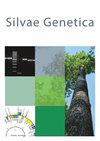日本特有雪茶树(Camellia rusticana)克隆结构及自交不亲和性研究
IF 1
4区 农林科学
Q3 FORESTRY
引用次数: 0
摘要
摘要研究了日本特有种山茶(Camellia rusticana)的克隆结构、自交不亲和性和单果种子数,并与相近的日本山茶(C. japonica)进行了比较。无性系繁殖较强,居群间无性系结构存在差异。即使在恶劣的环境中,如高海拔地区,积雪也相当多,因为即使一个存活的基因也可以进行无性繁殖。然而,有性繁殖(即通过种子繁殖)有利于分散到遥远的适宜栖息地。人工杂交结果表明,与粳稻一样,中国稻也具有高度的自交不亲和性。此外,每颗果实的种子数也低于粳稻。尽管种子产量很低,但自交不亲和可能在高质量种子的生产中起作用。本文章由计算机程序翻译,如有差异,请以英文原文为准。
Investigation of Clonal Structure and Self-incompatibility in Japanese Endemic Snow Camellia (Camellia rusticana)
Abstract We investigated the clonal structure, self-incompatibility, and number of seeds per fruit in Camellia rusticana, a Japanese endemic species, in comparison to the closely related C. japonica. Clonal propagation was more vigorous in C. rusticana than in C. japonica and the clonal structure of C. rusticana varied among populations. C. rusticana can maintain genets for extended periods, even in harsh environments such as high-altitude areas with considerable snow accumulation, because even a single surviving genet can propagate clonally. However, sexual reproduction (i.e., reproduction by seed) is advantageous for dispersal to distant suitable habitats. An artificial crossing test revealed high self-incompatibility in C. rusticana, as observed in C. japonica. In addition, the number of seeds per fruit was lower in C. rusticana than in C. japonica. Self-incompatibility in C. rusticana may play a role in production of high-quality seed, despite low seed production.
求助全文
通过发布文献求助,成功后即可免费获取论文全文。
去求助
来源期刊

Silvae Genetica
农林科学-林学
CiteScore
2.20
自引率
10.00%
发文量
10
审稿时长
3 months
期刊介绍:
Silvae Genetica is an international peer reviewed journal with more than 65 year tradition and experience in all fields of theoretical and applied Forest Genetics and Tree breeding. It continues "Zeitschrift für Forstgenetik und Forstpflanzenzüchtung" (Journal of Forest Genetics and Forest Tree Breeding) founded by W. LANGNER in 1951.
 求助内容:
求助内容: 应助结果提醒方式:
应助结果提醒方式:


